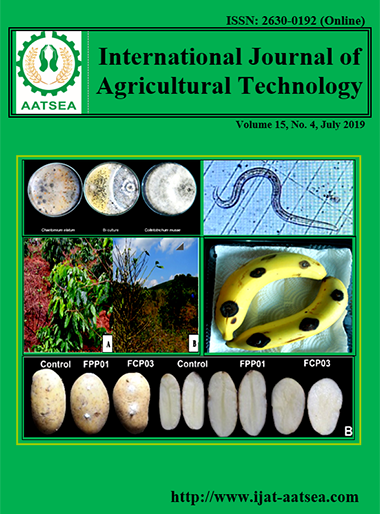Rubber production system and livelihood of smallholding rubber farming system (SRFS) in southern Thailand: A case study in provinces of Nakhon Si Thammarat, Phatthalung and Trang
Main Article Content
Abstract
The farming system, production management, technology usage, livelihood, vulnerability, and factors was examined the influence on the vulnerability of livelihoods of smallholding rubber farmers along with other agricultural activities. The studied locations were those of Pa Bon district, Tamot district, Bang Kaeo district in Phatthalung province; Ron Phibun district and Lan Saka district in Nakhon Si Thammarat Province; and Na Yong district, Kantang district, and Yan Ta Khao district in Trang province. The number of 399 households and 60 key informants were selected as a sample group. The results indicated that working with rubber farming could be classified into 5 systems that were 1) mono-rubber-tree farming system (53.85%), 2) inter-fruit-tree with the rubber-tree farming system(14.48%) such as durian and longkong, 3) rubber-tree with rice farming system (8.27%), 4) rubber-tree with the oil-palm farming system (19.22%), and 5) rubber-tree farming with animal raising system (4.18%). For livelihoods of rubber farmer households under these 5 systems, the results reflected all 5 systems that the social capitals were quite high when the economic capitals were quite low. For the livelihood success among the 5 systems, the study indicated that to get a net income, reducing limitation strategies, and top know well-being under the oil-palm farming system had higher averaged values than all of the other systems. For the 10-year economic model (2017-2026), the study indicated that inter-fruit-tree with the rubber-tree farming system, rubber-tree with the oil-palm farming system, and rubber-tree farming with the animal raising system had high marginal marketing when compared with the others. For the model of rubber production pattern and livelihood under rubber farming system along with other agricultural activities for sustainable development in the 3 provinces, the study classified the system into 4 sub-models s as follows:- 1) production system, 2) support system, 3) strategy and livelihood adjustment system, and 4) the resulted sustainable livelihood system.
Article Details

This work is licensed under a Creative Commons Attribution-NonCommercial-NoDerivatives 4.0 International License.
References
Athipanan, W. (1999). Area and community analysis: Farming system concept in agricultural extension work. Bangkok: Agri-business Promotion Group.
Boonchu. P. (1990). Agricultural technical officers’ attitude toward farming system research. Songkhla: Department of Agricultural Development, Faculty of Natural Resources, Prince of Songkla University.
Cherdchom, P., Prommee, P. and Somboonsuke, B. (2009). Economic performances of small holding rubber-based farms in southern region Thailand: Case study in Khao Phra, Phijitt and Khlong Phea Communities Songkhla province. Kasetsart Journal (Soc. Sci), 23:151-166.
Choengsa-at, U. (1991). Integrated agricultural system. Bangkok: Agri-business Promotion Group, Department of Agricultural Extension.
Nusang, R. (2006). The socio-economic adjustment of rubber smallholders in smallholding rubber-rice farming system in Khao Chaison, Amphoe Khao Chaison, Changwat Phatthalung. (Unpublished master’s thesis). Prince of Songkla University, Songkhla.
Office of the National Economic and Social Development Board (2015). Thai Economic Performance in Q1 2015 and Outlook for 2015. Office of the National Economic and Social Development Council 962 Krung Kasem Road, Pomprab, Bangkok.
Rubber Authority of Thailand (RAOT) (2017). Rubber information: Rubber database system. Retrieved March 1, 2017 from http://emarket.raot.co.th/rdu/.
Somboonsuke, B., Pacheerat, K. and Wettayaprasit, P. (2009). A Socio-economic simulation of rubber smallholding systems: A Case study of Phatthalung and Songkhla provinces in southern Thailand. CMU Journal of Social Sciences and Humanities, 3:113-134.
Somboonsuke, B., Demaine, H. and Shivakoti, G. P. (2002). Rubber-based farming system in Thailand: Problems, Potential, Solution, and Constraints. Journal of Rural Development, 21:85-113.
The Department for International Development (DFID) (2001). Sustainable livelihoods guidance sheets. DFID 94 Victoria Street, London, pp.150.


